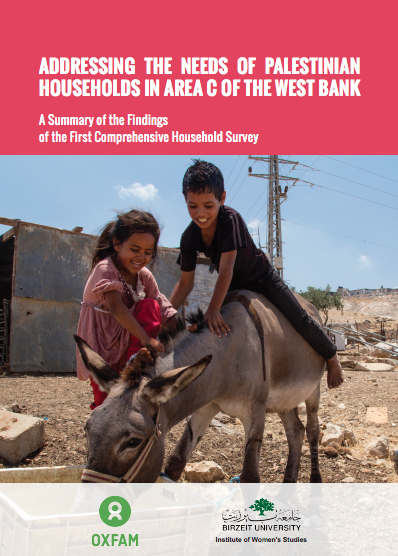Addressing the Needs of Palestinian Households in Area C of the West Bank. Findings of the First Comprehensive Household Survey (January 2019)
A joint project of the Institute of Women’s Studies & the Development Studies Center at Birzeit University on behalf of Oxfam
SUMMARY OF FINDINGS
About this Report: This report on households in Area C – the territory comprising more than 60% of the occupied West Bank and which is heavily restricted by Israeli military control – describes in quantitative and qualitative detail the lives of the approximately 300,000 Palestinians who live there.
It is based on the first and only comprehensive and representative statistical survey of Palestinian households located in Area C, offering a detailed overview of their demographic, socio-economic, and human security situation while providing a statistical baseline for future surveys. The 2014 baseline survey of 1,600 households had a very low margin of error, less than 2%. It is augmented by a second smaller survey of 400 households conducted in 2017 in order to assess stability and change in trends identified three years prior, as well as by findings from focus groups and individual interviews carried out in four different Area C communities that represent regional and other main characteristics of the survey sample design.
Aims of this Report: The study aims to round out the substantial human rights evidence base on community level circumstances in Area C, with household level data from the first base-line social survey of the Palestinian population there. The base-line survey (which forms the core of this report) provides in-depth data showing how various aspects of the protracted protection crisis and destructive mechanisms related to Israeli policies have translated into different circumstances and dynamics at the household level in Area C. It provides a range of indicators suggesting how macro-level policies (over more than two decades) have shaped the livelihoods, wellbeing and future life chances of men, women, and children in Area C households. It also points to variations in circumstances, highlighting significant patterns of greater household distress and deprivation in specific regions of Area C and among specific community types, as well as gendered differences in their impacts and experiences of them.
Ultimately, by providing a more comprehensive and in-depth picture of how women and men in households across Area C experience their circumstances, respond to them, as well as perceive their needs and options, the report hopes to contribute to the development of more effective and better targeted strategies for intervention and advocacy on their behalf.
Download

